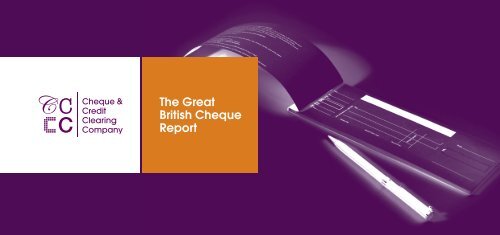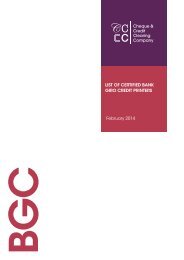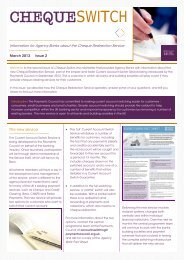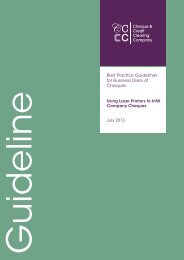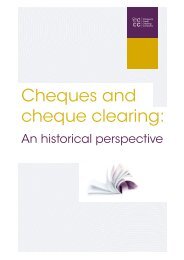The Great British Cheque Report - Cheque and Credit Clearing ...
The Great British Cheque Report - Cheque and Credit Clearing ...
The Great British Cheque Report - Cheque and Credit Clearing ...
- No tags were found...
Create successful ePaper yourself
Turn your PDF publications into a flip-book with our unique Google optimized e-Paper software.
<strong>The</strong> <strong>Great</strong><strong>British</strong> <strong>Cheque</strong><strong>Report</strong>
One of the oldest surviving cheques in the UK.Reproduced by kind permission of <strong>The</strong> Royal Bank of Scotl<strong>and</strong> Group © 2009.<strong>The</strong> <strong>Great</strong> <strong>British</strong> <strong>Cheque</strong> <strong>Report</strong>55
Example of an early cheque from the 1820s, with scrollwork between cheque <strong>and</strong> counterfoil.© <strong>Cheque</strong> & <strong>Credit</strong> <strong>Clearing</strong> Company 2009<strong>The</strong> <strong>Great</strong> <strong>British</strong> <strong>Cheque</strong> <strong>Report</strong> 7
eported from 1811, although the practice may have beenintroduced from its inception in 1810. <strong>The</strong> bank printed the nameof the account holder vertically along the left-h<strong>and</strong> edge. Bothof these companies eventually became part of <strong>The</strong> Royal Bankof Scotl<strong>and</strong> Group.<strong>The</strong> informal exchange of cheques in various locationscontinued until about 1770 when the practice of clearing wasofficially recognised by the private bankers in the City. In 1773a room was hired specifically for the clearing of cheques <strong>and</strong>bills in the “Five Bells” tavern, Dove Court, off Lombard Street,but it was almost a century before the clearing of chequesbecame the main feature of the clearing house. When the“Five Bells” was found to be too small, a larger room was takenin a private house next door. <strong>The</strong>n, in about 1805, premiseswere taken next to the offices of the bankers Messrs Smith,Payne & Smith in Lombard Street.Following the formation of a permanent committee of bankersin 1821 to regulate the clearing (later known as the Committeeof London <strong>Clearing</strong> Bankers), the first clearing house building,initially owned by a group of private bankers, was built inLombard Street in 1833. Apart from when the clearing wastransferred to Stoke-on-Trent during World War II, cheques wereexchanged in Lombard Street for 150 years. <strong>The</strong>re have beenchanges in membership over the years, first with the growthof private bankers, then in 1854 the new joint stock banks(corporately owned banks) were admitted <strong>and</strong> the Bank8<strong>The</strong> <strong>Great</strong> <strong>British</strong> <strong>Cheque</strong> <strong>Report</strong>
of Engl<strong>and</strong> joined in 1864. In more recent years, changes havebeen mainly due to mergers <strong>and</strong> acquisitions. As volumes<strong>and</strong> values grew, in 1854 settlement in cash was replaced bysettlement across accounts held at the Bank of Engl<strong>and</strong> usingcheques drawn on the Bank – an arrangement that continuestoday, albeit by electronic means.Over the years the process of producing, using <strong>and</strong> processingcheques has gradually become more sophisticated. From theexchange of cheques between messengers at the “Five Bells”tavern in 1773, to today’s <strong>Cheque</strong> <strong>and</strong> <strong>Credit</strong> <strong>Clearing</strong>Company (established in 1985), the way in which chequepayments are processed has become more automated <strong>and</strong>more st<strong>and</strong>ardised, <strong>and</strong> modern cheque processing machinescan read around 1,000 to 1,800 items per minute.To improve the take-up of cheques as a means of payment,which itself led to many more bank accounts being opened,the first cheque card was introduced in October 1965,guaranteeing payment of sterling cheques up to a value of£30. This limit was raised in 1977 to £50 <strong>and</strong> two additional limitsof £100 <strong>and</strong> £250 were introduced in 1989. In July 1969 the UKDomestic <strong>Cheque</strong> Guarantee Card Scheme was establishedto create common, easily-identifiable design featuresto simplify acceptance procedures for retailers <strong>and</strong> otherbusinesses. Since 1 October 1990 the common themeappearing on all participating cards has been the bustof William Shakespeare.<strong>The</strong> <strong>Great</strong> <strong>British</strong> <strong>Cheque</strong> <strong>Report</strong> 9
Security measures have been greatly improved over the lasthalf-century. Since 1995, all cheque printers must be membersof the <strong>Cheque</strong> Printer Accreditation Scheme (CPAS). <strong>The</strong>Scheme is managed by the <strong>Cheque</strong> <strong>and</strong> <strong>Credit</strong> <strong>Clearing</strong>Company <strong>and</strong> requires that all cheques, for use in <strong>Great</strong> Britain,are produced by accredited printers who must follow stringentsecurity st<strong>and</strong>ards.In 1996, as well as exchanging the physical paper, code line<strong>and</strong> amount details of cheques began to be transmitted fromthe beneficiary’s bank (the collecting bank) to the payer’sbank (the paying bank) via a secure electronic network calledInter Bank Data Exchange, or IBDE.<strong>Cheque</strong>s continue to be physically exchanged because thepaying bank is responsible for detecting fraud <strong>and</strong> for ensuringthat they are paying the cheque in accordance with theircustomer’s m<strong>and</strong>ate - the only reliable way to do this is throughphysical examination of the cheque itself. <strong>The</strong> requirement toundertake a physical check for security purposes is the reasonwhy the cheque clearing process takes days rather than hours.<strong>The</strong> definition <strong>and</strong> use of cheques are covered by legislation,including <strong>The</strong> Bills of Exchange Act 1882, <strong>and</strong> also the <strong>Cheque</strong>sActs of 1957 <strong>and</strong> 1992. <strong>The</strong> Bills of Exchange Act 1882 defines acheque as a written order from an account holder instructingtheir bank to pay a specified sum of money on dem<strong>and</strong> to oneor more named beneficiaries. However cheques are not – <strong>and</strong>10<strong>The</strong> <strong>Great</strong> <strong>British</strong> <strong>Cheque</strong> <strong>Report</strong>
never have been – legal tender. Even today, no creditor is legallyobliged to accept a cheque in payment of a debt. A creditor isentitled to be paid in legal tender <strong>and</strong> may refuse to acceptpayment in any other form.cheque; a six-digit sort code that identifies the bank <strong>and</strong> branchof the account; <strong>and</strong> the seven- or eight-digit account number.Today’s chequesToday’s cheque follows strict st<strong>and</strong>ards in the way it is printed <strong>and</strong>the information it contains. <strong>The</strong> writer is required to enter thename of the payee, the date, <strong>and</strong> the amount they wish to pay,together with a signature to verify the payment. <strong>The</strong> cheque alsocontains a code line. <strong>The</strong> st<strong>and</strong>ard information contained in thecode line of all cheques includes: the six-digit serial number,which is unique within each chequebook <strong>and</strong> identifies the<strong>The</strong> <strong>Great</strong> <strong>British</strong> <strong>Cheque</strong> <strong>Report</strong> 11
<strong>The</strong> cheque clearing process is also st<strong>and</strong>ardised, which meansthat customers paying a cheque, banker’s draft or buildingsociety cheque into a current, savings or basic bank accountcan expect to: earn interest on cheque funds within two workingdays of the cheque being paid in; withdraw the cheque fundsfour working days after the paying in day (although for savingsaccounts this is longer, six days rather than four); <strong>and</strong> areguaranteed that the money has cleared safely <strong>and</strong> can nolonger be withdrawn from their account without their consent sixworking days after the paying in day, unless they are a knowingparty to a fraud.customers with clarity <strong>and</strong> certainty never before made availablein the cheque’s 350-year history. Individual banks, however, docompete on when they will pay interest or allow funds from apaid in cheque to be withdrawn.Despite the changes <strong>and</strong> improvements to cheques <strong>and</strong> theclearing process, consumers are increasingly choosingalternative payment methods for the majority of their personal<strong>and</strong> business payments <strong>and</strong> this decline is widely accepted tobe irreversible. However, just a few decades ago cheques werein their heyday as a favoured payment method <strong>and</strong> cultural icon.<strong>The</strong>se maximum timescales, known as 2-4-6, are adhered to byall banks. <strong>The</strong>y were introduced in November 2007 <strong>and</strong> provide12<strong>The</strong> <strong>Great</strong> <strong>British</strong> <strong>Cheque</strong> <strong>Report</strong>
<strong>The</strong> 2-4-6 timescaleDaye.g. Monday<strong>The</strong> processstarts whenyour bankreceivesthe cheque 10Daye.g. no laterthan WednesdayYou start toreceive intereston the moneyfrom today 22Daye.g. no laterthan FridayYour bank willallow youto withdrawthe moneytoday 3Day4 6e.g. no laterthan TuesdayYou can be surethe money isyours by theend of today 41 You can pay in a cheque in a number of ways – across a branch counter, ata cash machine, by post or at a post office. This may affect when your bankactually receives the cheque. You may also need to deposit a cheque beforea certain cut-off time, so if certainty is important to you, you should checkwith your bank or building society.2 If your account pays interest on credit balances. It is also the point at which thismoney will reduce the balance on which overdraft interest is charged.3 Not necessarily for savings accounts.4 You will be able to withdraw this money from your savings account if the accountallows withdrawals.<strong>The</strong> <strong>Great</strong> <strong>British</strong> <strong>Cheque</strong> <strong>Report</strong> 13
5 Our love of cheques<strong>Cheque</strong>s at their peakDespite their appearance many years before, it was not untilthe late 19th century that cheques became widely used.This popularity continued, especially in the second half of the20th century when the vast majority of the population started tohold a bank account <strong>and</strong> have their salary paid directly into it,leading to less reliance on cash.<strong>The</strong>se changes went h<strong>and</strong>-in-h<strong>and</strong> with a great number ofpayments innovations – such as the introduction of the creditcard in 1966, the debit card in 1987, telephone banking in 1989<strong>and</strong> internet banking in 1997 – but these were in their infancycompared with cash <strong>and</strong> cheques. For most retailers, paymentby cash or cheque was st<strong>and</strong>ard, <strong>and</strong> in 1990 cheque volumeshit their peak with eleven million cheques issued each day. It wasnot until 2005 that debit cards finally toppled cash on the highstreet. Issuers of regular household bills – for example, utilitycompanies – tended to receive most payments by cheque,postal order, or by payment at a Post Office. Even as credit cardsgrew in popularity, cheques were one of the payment methodsof choice for paying credit card bills <strong>and</strong> remain so today.14<strong>The</strong> <strong>Great</strong> <strong>British</strong> <strong>Cheque</strong> <strong>Report</strong>
4FactIf all the cheques that went through the clearing systemin 1990 were laid end-to-end, they would stretch 12 timesaround the world.Volume (billions)3.532.521.510.501989 1990 1991 1992 1993 1994 1995 1996 1997 1998 1999 2000 2001 2002 2003 2004 2005 2006 2007<strong>Cheque</strong> volumes (1989-2007)<strong>The</strong> <strong>Great</strong> <strong>British</strong> <strong>Cheque</strong> <strong>Report</strong> 15
16Cultural iconNot only were cheques a popular <strong>and</strong> practical way to pay inthe 20th century; they were also appealing for other, more visualreasons. From as early as the 1920s <strong>and</strong> 1930s, businesses wereprinting cheques with their logos <strong>and</strong> br<strong>and</strong>ing, but through thelatter half of the 20th century, as television became morepopular, the cheque became a useful visual device. Easier <strong>and</strong>safer to carry than a briefcase full of cash, a giant cheque withbr<strong>and</strong>ing all over it provided an easy way for a company makinga donation to the Children in Need appeal to get themselvesnoticed. Similarly, as the media photocall has grown ever morepopular, the giant cheque is a useful prop to support anythingfrom a charity donation to a big lottery win!<strong>The</strong> <strong>Great</strong> <strong>British</strong> <strong>Cheque</strong> <strong>Report</strong>© Reproduced by kind permission of Select Education.
<strong>The</strong> cheque has also played a big part in some of Britain’s bestlovedgame shows. <strong>The</strong> BBC’s Blankety Blank ran from January1979 to March 1990, with a brief revival in the late 1990s. <strong>The</strong>show’s consolation prize was the ‘Blankety Blank chequebook<strong>and</strong> pen’. Despite the many jokes about the prize made by hostLes Dawson, these items are now extremely collectable, havingnever been commercially produced. Similarly, ITV game showWho Wants To Be a Millionaire?, which began in 1998, is still issuingwinners with cheques signed by host Chris Tarrant.As cheque usage declines, however, we may now be lookingat a younger generation that are familiar with cheques fromwhat they have seen on television, without ever having writtena cheque themselves.<strong>The</strong> <strong>Great</strong> <strong>British</strong> <strong>Cheque</strong> <strong>Report</strong> 17
6 Personal cheque usageSince 1990, cheques have declined in volume eachyear. Over the last ten years personal cheque use has morethan halved, with <strong>British</strong> adults making just 1.4 cheque paymentsper month in 2007, compared with 2.9 per month ten yearspreviously <strong>and</strong> receiving only around five cheques per year,compared with eight each year in 1997.FactSince 1985 the <strong>Cheque</strong> <strong>and</strong> <strong>Credit</strong> <strong>Clearing</strong> Company hascleared more than 44.8 billion cheques, with a value of£26,850 billion.However, cheques retain their popularity for certain payments,including subscriptions to clubs <strong>and</strong> societies <strong>and</strong> for payingbills, <strong>and</strong> in 2007 there were 2.4 million personal cheques writtenevery day.Volumes (billions)2.01.51.00.50.0199719981999200020012002200320042005200620071997199819992000200120022003200420052006200718<strong>The</strong> <strong>Great</strong> <strong>British</strong> <strong>Cheque</strong> <strong>Report</strong>Personal paymentsPersonal cheque volumes 1997 to 2007Personal cash aquisition
<strong>Cheque</strong>s out at the checkout<strong>The</strong> sharpest decline in cheque usage has been on the highstreet, where cheques have been completely overtaken as apayment method. <strong>The</strong> first major retailer to stop acceptingcheques was Shell, in 2005, <strong>and</strong> over the last three years mostother major retailers such as Tesco, Marks <strong>and</strong> Spencer, JohnLewis, Sainsbury’s <strong>and</strong> Boots have all followed suit. Retailershave pointed to a range of reasons for this decision, includingfalling use by customers, the comparatively higher processingcosts for cheques compared with other payment types, <strong>and</strong>fraud concerns.UK retail spending*2004 2005 2006 2007Debit cards £83bn £89bn £98bn £109bn<strong>Credit</strong> cards £61bn £61bn £60bn £61bnCash spending £84bn £81bn £81bn £84bn<strong>Cheque</strong>s £11bn £9bn £8bn £7.4bn* includes online spending<strong>The</strong> <strong>Great</strong> <strong>British</strong> <strong>Cheque</strong> <strong>Report</strong> 19
Household bills<strong>Cheque</strong>s have remained fairly popular for bill payments but heretoo they are in decline. Automated payments like the Direct Debit– introduced in the late 1960s – <strong>and</strong> st<strong>and</strong>ing orders areincreasingly the payment method of choice because of theirease <strong>and</strong> security. Many companies issuing regular householdbills have contributed to the rise in popularity by offeringdiscounts <strong>and</strong> incentives to customers choosing Direct Debits.% regular bill payments made by2002 2007 2012*Cash 27% 17% 12%<strong>Cheque</strong> 7% 4% 3%St<strong>and</strong>ing order/Direct Debit 61% 73% 78%Debit/credit card 2% 3% 4%Remote banking 1% 1% 2%Other 2% 2% 1%(credit card bills excluded)* Forecast20<strong>The</strong> <strong>Great</strong> <strong>British</strong> <strong>Cheque</strong> <strong>Report</strong>
<strong>Credit</strong> card bill payments2001 2004 2007Cash 17% 15% 11%<strong>Cheque</strong> 52% 38% 29%St<strong>and</strong>ing order/Direct Debit 16% 24% 29%Debit card 4% 5% 6%Remote banking 11% 18% 25%As with retail payments, more consumers are choosing to paytheir bills online, further accelerating the decline of the cheque.With the advent of Faster Payments in May 2008, online <strong>and</strong>phone payments can now potentially be made twenty-fourhours a day, seven days a week, <strong>and</strong> most payments areprocessed within a couple of hours. This new system may wellbe increasingly used as an alternative to cheques, both to paybills <strong>and</strong> for making person-to-person payments.What scenarios remain popular for chequeusage?In spite of the decline there were still 4.4 million personal <strong>and</strong>business cheques written every day in 2007 <strong>and</strong> there aremany situations where the cheque remains a popular paymenttool, including:• Payments to tradesmen• Payments to or from small to medium businesses<strong>The</strong> <strong>Great</strong> <strong>British</strong> <strong>Cheque</strong> <strong>Report</strong> 21
22• Person-to-person payments• Postal payments, such as gifts to individuals or charities• Subscriptions <strong>and</strong> other payments to clubs, societies <strong>and</strong>schools• Payments made by (or on behalf of) the housebound, orthose with physical impairments that make the use ofalternative payment mechanisms difficultWho still uses cheques?Today’s cheque users are not only those of us who areuncomfortable with newer payment methods. Women are morelikely to be regular cheque users than men. In 2007, 55 per cent ofwomen aged 35-44 <strong>and</strong> 53 per cent of women aged 45-54 were<strong>The</strong> <strong>Great</strong> <strong>British</strong> <strong>Cheque</strong> <strong>Report</strong>regular cheque users, compared with 22 per cent <strong>and</strong> 32 percent of men in comparable age groups. Parents in particular stilluse cheques for one-off costs such as school trips or after-schoolactivities for children.2007EDC2C1AB65+55 to 6445 to 5435 to 4425 to 3416 to 24FemaleMale0% 10% 20% 30% 40% 50% 60%Proportion of individuals making spontaneous payments by chequeat least once per month (2007)
RegionPercentage of adultsregularly using cheques<strong>The</strong>re are also significant differences across the country. InScotl<strong>and</strong>, 27 per cent of adults use cheques for spontaneouspayments compared with 44 per cent of adults in the South West.South West 44South East 43East Anglia 41East Midl<strong>and</strong>s 40Wales 38Yorkshire & the Humber 36<strong>Great</strong>er London 36North West 32North East 32West Midl<strong>and</strong>s 31Scotl<strong>and</strong> 27However, there are some people who have already stoppedusing cheques completely. According to consumer researchcarried out for the <strong>Cheque</strong> <strong>and</strong> <strong>Credit</strong> <strong>Clearing</strong> Company in2008, some 25 per cent of all account holders neither write norreceive cheques at all.<strong>The</strong> <strong>Great</strong> <strong>British</strong> <strong>Cheque</strong> <strong>Report</strong> 23
7 Business cheque usage<strong>The</strong> business payment l<strong>and</strong>scape has beencharacterised by continued migration away fromcheques to automated methods <strong>and</strong>, to a lesserextent, to plastic cards. Business cheque transactionvolumes peaked in 1997 at 1.2 billion <strong>and</strong> fell to 709million in 2007.regular payments, <strong>and</strong> large businesses find automated creditsmore cost-effective than cheques.1.51.2<strong>Cheque</strong>s continue to be popular for business-to-businesspayments, accounting for 40 per cent of all non-cash payments.When making payments to other businesses, companies of allsizes are most likely to use cheques to pay trade suppliers. <strong>The</strong>yare least likely to use cheques when the payment arises fromregular commitments such as rent, business rates or utility bills.Direct Debits are often used by smaller businesses for theseVolume (billions)0.90.60.30.01997 1998 1999 2000 2001Business cheque volumes 1997-200720022003200420052006200724<strong>The</strong> <strong>Great</strong> <strong>British</strong> <strong>Cheque</strong> <strong>Report</strong>
8 Euro cheques in the UK2009 marks the tenth anniversary of the advent of the <strong>British</strong>euro cheque clearing system, which was established tocoincide with the launch of the euro.Many people are not even aware that euro-denominatedcheques issued by UK banks exist <strong>and</strong> that they can be used topay for certain goods <strong>and</strong> services in the UK. Those banks whichoffer customers euro-denominated cheque services generally doso as part of a UK euro bank account. <strong>The</strong>se cheques can only beused in the UK <strong>and</strong> when they are paid into euro bank accountsin <strong>Great</strong> Britain they are processed through the euro chequeclearing, which is managed by the <strong>Cheque</strong> <strong>and</strong> <strong>Credit</strong> <strong>Clearing</strong>Company. <strong>The</strong> clearing of euro cheque payments in NorthernIrel<strong>and</strong> is managed by the Belfast Bankers <strong>Clearing</strong> Company.Euro cheques are used mostly by businesses (the average valueof a euro cheque in 2007 was the sterling equivalent of £5,630)<strong>and</strong> the volumes are very small. In 2007, the total number of eurocheques that passed through the clearings was 531,000, whichcompares to 1.1 billion items passing through the sterling chequeclearings. Annual clearing volumes for euro cheques peaked in2003 at 729,000 <strong>and</strong> since then volumes have declined everyyear. <strong>The</strong> average daily volume of just 2,100 items passing throughthe clearing in 2007 compares to a daily average volume forsterling items of 4.4 million.<strong>The</strong> <strong>Great</strong> <strong>British</strong> <strong>Cheque</strong> <strong>Report</strong> 25
<strong>The</strong> clearing process for euro cheques paid into euro-basedbank accounts in <strong>Great</strong> Britain is a manual process involvingthe physical exchange of the cheques at the English or ScottishExchange centres used for sterling cheques. <strong>The</strong>re is noexchange of electronic data as there is for sterling cheques.<strong>The</strong> banks settle with each other through the Central Bank <strong>and</strong>Financial Services Authority of Irel<strong>and</strong>.26<strong>The</strong> <strong>Great</strong> <strong>British</strong> <strong>Cheque</strong> <strong>Report</strong>
9 International cheque usage<strong>Cheque</strong> usage in countries around the world variesconsiderably. However, volumes have been falling long-termin nearly all nations, but more rapidly in some than others.<strong>The</strong> Netherl<strong>and</strong>s no longer uses the cheque at all, <strong>and</strong> its usein several other European countries, such as Belgium, Germany,Switzerl<strong>and</strong> <strong>and</strong> Sweden, is extremely low.At the other end of the scale, cheques formed about a third ofnon-cash payments in the United States in 2006 (the latest year forwhich international figures are available) <strong>and</strong> roughly a quarterof those in France. <strong>The</strong> UK falls between these extremes, withabout one non-cash payment in eight made by cheque in 2006.United States *FranceNew Zeal<strong>and</strong>**United KingdomAustraliaGermanySwedenAverage annual rate of decline20062002<strong>The</strong> Netherl<strong>and</strong>s-50% 0 50 100 150 200Number of cheque payments per adult (selected countries).* Including cheques presented in bill payment or at retailers <strong>and</strong> then converted toe-checks, amounting to 0.9 <strong>and</strong> 10.4 in 2002 <strong>and</strong> 2006 respectively. Excluding thesecheques the average annual rate of decline of cheques processed was 7%.** Includes paper credits.Sources: BIS Red Book, US Federal Reserve, New Zeal<strong>and</strong> Bankers' Association<strong>The</strong> <strong>Great</strong> <strong>British</strong> <strong>Cheque</strong> <strong>Report</strong> 27
10 <strong>The</strong> futureSo what next for the <strong>Great</strong> <strong>British</strong> <strong>Cheque</strong>?<strong>The</strong> UK enjoys one of the best, most efficient <strong>and</strong> variedpayment systems in the world. We are a nation increasinglyconfident in managing our household bills, shopping <strong>and</strong> oneoffpayments from our homes or offices, <strong>and</strong> 24-hour paymentsystems <strong>and</strong> services have developed to suit our increasinglybusy lifestyles.In May 2008 the Payments Council published the first-everNational Payments Plan, setting strategy for payments for the nextten years. A main focus of the Plan is the future of cheques, <strong>and</strong>a major programme of work has been initiated to develop a set ofactions to address this. <strong>The</strong>se will include a timetable for developingalternatives to cheques, an objective review of the UK Domestic<strong>Cheque</strong> Guarantee Card Scheme, an education <strong>and</strong>marketing plan on alternatives to cheques <strong>and</strong>, potentially,a target end date for the cheque clearing. <strong>The</strong> Plan highlightsthat the long-term decline of cheques needs to be managedcarefully, <strong>and</strong> the Payments Council has emphasised thatacceptable alternative arrangements to cheques have to beavailable to all users before the closure of the cheque clearingcan be seriously contemplated.28<strong>The</strong> <strong>Great</strong> <strong>British</strong> <strong>Cheque</strong> <strong>Report</strong>
0.80.60.40.20.0200820092010201120122013201420152016201720082009Volume (billions)201020112012201320142015201620172008200920102011201220132014201520162017Personal paymentsBusiness paymentsCash acquisitionUK cheque transaction volume forecast (billions)<strong>The</strong> <strong>Great</strong> <strong>British</strong> <strong>Cheque</strong> <strong>Report</strong> 29
<strong>Cheque</strong> <strong>and</strong> <strong>Credit</strong> <strong>Clearing</strong> Company<strong>The</strong> <strong>Cheque</strong> <strong>and</strong> <strong>Credit</strong> <strong>Clearing</strong> Company isa membership-based industry body, which hasmanaged the cheque clearing system in <strong>Great</strong>Britain for 24 years. <strong>The</strong> system is also used to processbankers' drafts, building society cheques, postalorders, warrants <strong>and</strong> government payable orders.<strong>The</strong> company also manages the systems for clearingpaper bank giro credits <strong>and</strong> euro cheques.<strong>The</strong> <strong>Cheque</strong> <strong>and</strong> <strong>Credit</strong> <strong>Clearing</strong> Company remainscommitted to maintaining the integrity of theclearing systems to ensure that all the clearingshappen on time, reliably <strong>and</strong> to quality st<strong>and</strong>ards.<strong>The</strong> role of the company is to:• Provide <strong>and</strong> run the exchange centres in Engl<strong>and</strong> <strong>and</strong>Scotl<strong>and</strong> where the members exchange their cheques <strong>and</strong>paper credits;• Provide the Inter-Bank Data Exchange (IBDE) networkacross which the banks transmit electronic details aboutthe cheques;• Calculate the net amounts members must settle with eachother based on the value of the cheques <strong>and</strong> creditsexchanged <strong>and</strong> advise the amounts to the settlementservice provider;30<strong>The</strong> <strong>Great</strong> <strong>British</strong> <strong>Cheque</strong> <strong>Report</strong>
• Determine the rules required to maintain the integrity of theclearing systems to ensure that the central clearing processhappens on time, reliably <strong>and</strong> to quality st<strong>and</strong>ards;• Ensure that participating members comply with thesystem rules.<strong>The</strong> company establishes the criteria for membership of theclearing systems; these criteria must be objective, fair <strong>and</strong> open.requires that all cheques for use in the GB clearing areproduced by accredited printers who have adopted stringentsecurity st<strong>and</strong>ards.<strong>The</strong> clearing of cheque <strong>and</strong> credit payments in NorthernIrel<strong>and</strong> is managed by the Belfast Bankers <strong>Clearing</strong> Company.<strong>The</strong> company also manages the <strong>Cheque</strong> Printer AccreditationScheme (CPAS). This scheme was introduced in 1995 with theaim of tackling fraud involving company cheques. <strong>The</strong> scheme<strong>The</strong> <strong>Great</strong> <strong>British</strong> <strong>Cheque</strong> <strong>Report</strong> 31
Mercury House Triton Court14 Finsbury Square London EC2A 1LQTel 020 7711 6200 | Fax 020 7256 5527www.cheque<strong>and</strong>credit.co.uk© <strong>Cheque</strong> <strong>and</strong> <strong>Credit</strong> <strong>Clearing</strong> Company Ltd 2009


